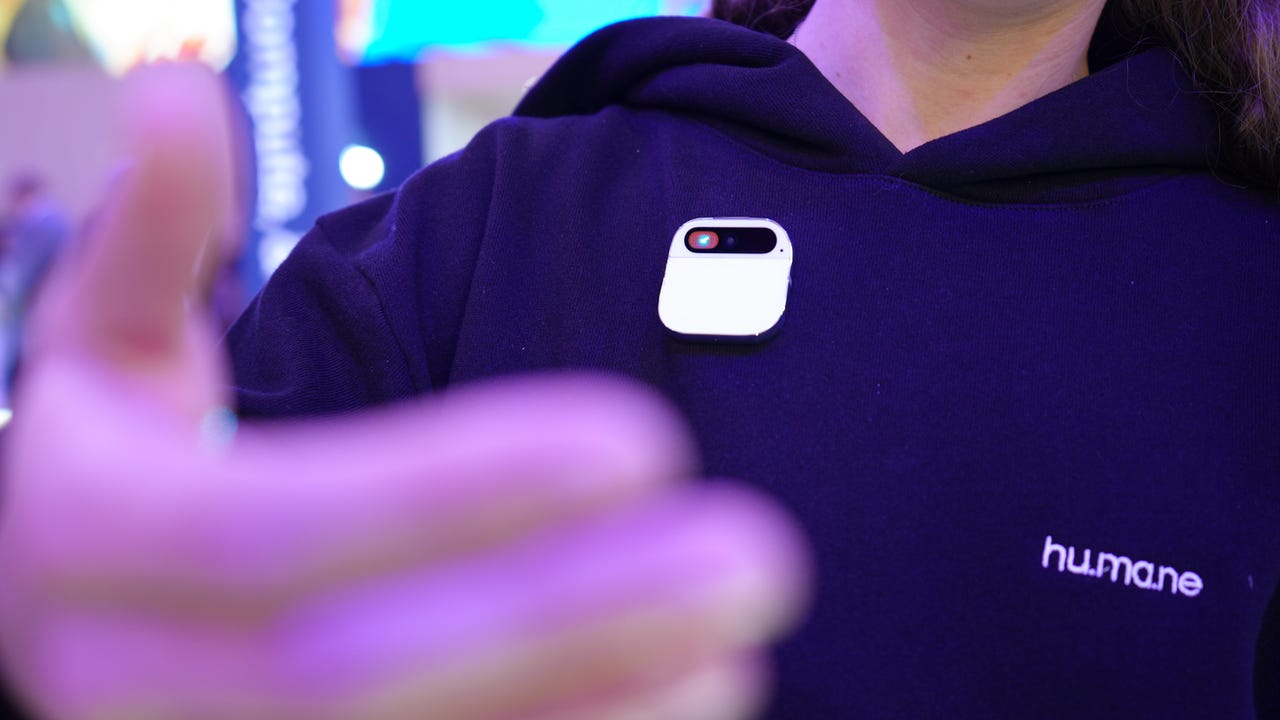
By now, the Humane AI Pin needs no introduction. It’s one of the first hardware devices to go all-in on the AI assistant craze, and that’s why I’m scratching my head as I write this article, wondering why I didn’t, for a second, expect the company to have a presence at Barcelona’s Mobile World Congress.
Also: Is your next home assistant a hologram? These MWC concepts offer 3 possibilities
Perhaps it was the fact that Humane doesn’t actually have a booth at the trade show. Instead, it’s scattered a team of engineers and designers to demo the AI Pin in the spaces of partnering companies such as SK Telecom and Qualcomm. Occasionally, Sai Kambampati and Liz Dorman, two of the demonstrators, can be found roaming the show floor, as if they are comparing their Pokemon cards to that of other brands. Only in this case, it’s an AI device versus what is very likely another AI device.
I bumped into the Humane duo as I was surrounded by magenta walls, reasoning with T-Mobile’s AI concept phone. The contrast between the white case on Kambampati’s Pin and his black Humane hoodie made it hard to miss. It was one of those “if you know, you know” moments.
I’ve covered the Humane AI Pin extensively over the past year, and have been following the brand’s stealthy upbringing for longer, but this was the first time I saw its debut consumer product in person. So my eyes and ears were open, and the demo began.
First, the basic voice command, with a long tap on the surface of the Pin. “How many people attend Mobile World Congress?”, Kambampati asked. The Pin, which was Bluetooth-paired to a mini speaker beneath his hoodie, responded shortly with a number that the two of us could only believe was accurate. In situations that require more research, the Pin will give a buffer statement like “Searching for attendees,” as it scrapes the web.
Also: This AI startup made a $199 gadget that replaces apps with ‘rabbits’ – and it might just work
I have two thoughts here: 1) I was impressed with how quick the Pin was when answering straightforward questions. If I’m walking around town or driving and want to fact-check something, I’d hope for short and consistent response times. In the context of answering questions at a bustling trade show, the Pin did not disappoint. 2) What about the loudness of the Pin’s built-in audio? The need to tuck in an extra speaker didn’t give me much confidence, but then again, I’m not expecting to broadcast my conversations with the wearable all that often.
The Pin’s projection was bright and clear. Kerry Wan/ZDNET
Then came the killer feature of the Pin, the Laser Ink Display that’s projected onto the user’s raised palm. Sure, turning your body into a digital user interface gives you all the sci-fi street cred, but there’s actually some practicality here. After you ask a question, triggering the Laser Ink Display projects the answer instead of having the Pin read it out loud. It’s perfect for any embarrassing questions, which, as a first-timer in Barcelona, I’ve had plenty of.
The 3D sensor and mapping of the digital interface were spot-on, too, with the projection remaining centered even as each demonstrator’s hands were shifting around. Pinch and leaning gestures would cause the visual to distort a bit, but not to the point that made it illegible.
Also: I tried the Samsung Galaxy Ring and it beats the Oura in 2 meaningful ways
Ultimately, did the live demos sell me on Humane’s ambitious new wearable? Sort of. I’m still unclear on how the dynamics will be living with a smartphone and the AI Pin, and the value proposition of a $699 first-gen product with a $24-per-month subscription is still a questionable commitment for many people, myself included.
But the near frictionless interactions with an always-nearby AI companion make so much sense in situations where context is invaluable. “How much is one euro in US dollars?”, “What’s the best route to the Fira Barcelona Gran Via?”, “Is there a pharmacy nearby?”, are all questions I’d love to get answers to without having to pull out my phone from my zippered pocket, unlock it, and then manually type into Google for. In this regard, I’m all for a device like the Humane AI Pin.

